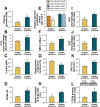Adolescent Obesity and Insulin Resistance: Roles of Ectopic Fat Accumulation and Adipose Inflammation
- PMID: 28192105
- PMCID: PMC9390070
- DOI: 10.1053/j.gastro.2016.12.051
Adolescent Obesity and Insulin Resistance: Roles of Ectopic Fat Accumulation and Adipose Inflammation
Abstract
As a consequence of the global rise in the prevalence of adolescent obesity, an unprecedented phenomenon of type 2 diabetes has emerged in pediatrics. At the heart of the development of type 2 diabetes lies a key metabolic derangement: insulin resistance (IR). Despite the widespread occurrence of IR affecting an unmeasurable number of youths worldwide, its pathogenesis remains elusive. IR in obese youth is a complex phenomenon that defies explanation by a single pathway. In this review we first describe recent data on the prevalence, severity, and racial/ethnic differences in pediatric obesity. We follow by elucidating the initiating events associated with the onset of IR, and describe a distinct "endophenotype" in obese adolescents characterized by a thin superficial layer of abdominal subcutaneous adipose tissue, increased visceral adipose tissue, marked IR, dyslipidemia, and fatty liver. Further, we provide evidence for the cellular and molecular mechanisms associated with this peculiar endophenotype and its relations to IR in the obese adolescent.
Keywords: Adipose Tissue Distribution; Adipose Tissue Inflammation; Childhood and Adolescent Obesity; Fatty Liver; Inflammasome; Resistance.
Copyright © 2017 AGA Institute. Published by Elsevier Inc. All rights reserved.
Conflict of interest statement
Conflicts of interest
The authors disclose no conflicts.
Figures




References
-
- Skinner A, Skelton JA. Prevalence and trends in obesity and severe obesity among children in the United States, 1999–2012. JAMA Pediatr 2014;168:561–566. - PubMed
-
- Ogden CL, Flegal KM, Carroll MD, et al. Prevalence and trends in overweight among U.S. children and adolescents, 1999–2000. JAMA 2002;288:1728–1732. - PubMed
-
- Biro FM, McMahon RP, Striegel-Moore R, et al. Impact of timing of pubertal maturation on growth in black and white female adolescents: The National Heart, Lung, and Blood Institute Growth and Health Study. J Pediatr 2001;138:636–643. - PubMed
-
- Bacha F, Saad R, Gungor N, et al. Obesity, regional fat distribution, and syndrome X in obese black versus white adolescents: race differential in diabetogenic and atherogenic risk factors. J Clin Endocrinol Metab 2003;88:2534–2540. - PubMed
Publication types
MeSH terms
Substances
Grants and funding
LinkOut - more resources
Full Text Sources
Other Literature Sources
Research Materials

